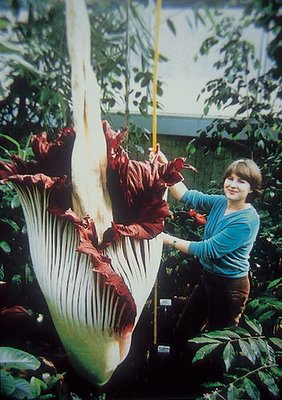
The King Of Stinky!
Amorphophallus titanium is the largest of the stink lilies! This giant arum originates in the moist shaded rainforests of Sumatra. In the wild, when growing in the ground the blooms can get up to 12 feet tall and 5 feet wide. In the leaf cycle, it can grow up to 20 feet high and 15 feet across. The first European botanist to encounter it was the Italian, Odoardo Beccari, who was traveling in the region in 1878. He sent back seeds to his patron in Italy and one of the young plants that germinated from them was subsequently dispatched to Kew, where it flowered in 1889, exciting great public interest. In 1926, when it flowered again, the crowds attracted by the phenomenon were so large that the police were called to control them.
The largest flower in the world, also a native of Sumatra, is Rafflesia arnoldii, which also deceives insects with the smell of decay. Amorphophallus titanium grows from a corm of up to 50 centimeters diameter and weighing over 50 kilograms (the heaviest recorded was 75 kilograms). After a dormant period of several months, a bud will develop, growing at a rate of 4-20 centimeters a day.
The flower attracts dung and carrion beetles by exuding a rotten smell. They enter the chamber in the lower part of the flower, where they fertilize the female flower if they are carrying pollen from another bloom. On the way out, the insects are coated with pollen that they may then carry to another plant. Like the Rafflesia, the flowering period of the Amorphophallus is brief - two to three days - after which the flower collapses.
Another interesting note about the plants in the genus Amorphophallus is that they are able to generate heat (thermogenic plants). At the peak of its metabolic activity, the plant’s blossom can be as much as 15 degrees Celsius (59 degrees F.) above its surrounding temperature. To generate this much heat, the metabolic rate of the plant must be close to that of a flying hummingbird. Reason for this heat production is the plant “cooks off” the smell of rotting meat in order to attract insects. Once inside the blossom, the heat causes the insects to remain very active to better carry out their pollination duties.
The website below is from Fairchild Tropical Botanic Garden, 10901 Old Cutler Road, Coral Gables, FL where Amorphophallus titanium bloomed on June 4-27, 1998. It is so impressive. Can you image the smell this critter pumps out from the blossom?
http://www.fairchildgarden.org/blooms/moreamorph.html


0 Comments:
Post a Comment
<< Home